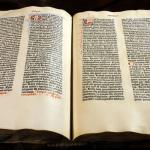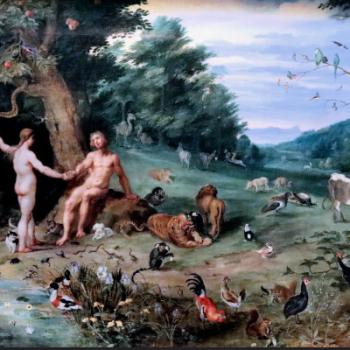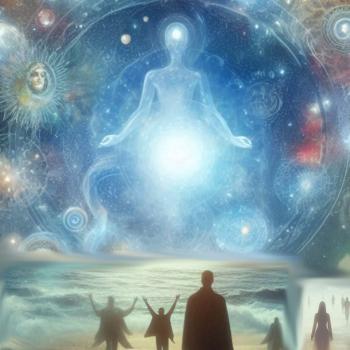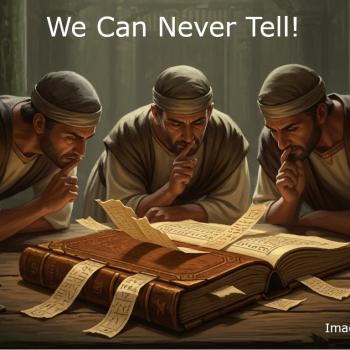Series: The Big Questions
There are a variety of attitudes about what the Bible is. At one extreme the Bible is the only official word of God. At the other extreme it’s a series of fairy tales. It’s generally regarded as guidance for humanity.
In its simplest form the Bible contains stories about a series of agreements (covenants) between God and man, mostly about behavior. The agreements take the form of “if … then” statements: “If you do this, God will do this,” either benevolently or as punishment.
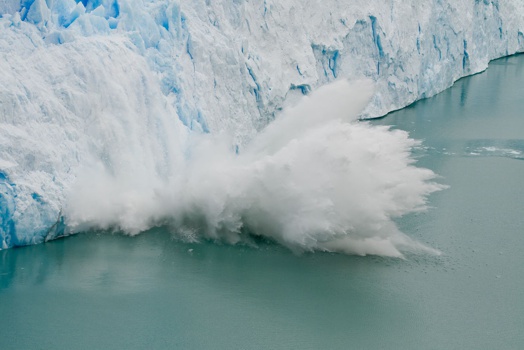
Ice Age – the beginning of history?
We don’t know much about humanity before the Ice Age. There are a number of hints in the archaeological record of civilizations before that time but little about what they were like. Later civilizations all had their creation stories, and from around the world came stories about a great flood.
The first Bible story after creation is about Adam and Eve. It’s allegorical but with a message the ancients thought important. Most cultures have a similar story. The agreement God had with them was that they could live in their idyllic setting forever if they would not eat of the Tree of Good and Evil.
God created them so likely knew what they would do, so we know the story was likely a mark of personal growth because everyone would want to know about the secrets of good and evil. They broke the agreement and God kicked them out of their eternal paradise to experience good and evil for themselves. There is hardly any personal growth without experience.
The Flood Story
The second story common around the world was about a great flood. Many archaeologists scoff at this saying there is no evidence of a singular worldwide flood … except for the evidence of a great flood.
During the recurring Glacial Period the ice across the North American continent was one to two miles deep. The buildup of ice caused ocean levels to drop around 400 feet. The Ice Age ended at the end of the last glacial period, about 10,000 years ago. It caused tremendous flooding as the ocean levels rose 400 feet and erased huge areas of land, separating them from continents.
Four hundred feet is a huge change. For example, Houston, Texas is currently only 50 feet above sea level. Chicago, Illinois is 597 feet above. New York City is only 33 feet. St. Louis, Missouri is 466 feet. If the Arctic melts because of Climate Change, the ocean will rise another 230 feet so most coastal cities will disappear, and many smaller islands in the ocean are already disappearing.
In addition to Ice Age melting, there is evidence of previous severe flooding in the Black Sea. Evidence of previous villages from around 6,000 years ago is found eight feet below the surface. “According to ‘The Black Sea Deluge‘ a catastrophic rise in the level of the Black Sea circa 5600 BC was due to waters from the Mediterranean Sea breaching a sill in the Bosporus Strait.
The Black Sea is near Mt. Ararat that figures prominently in the Noah flood story. Noah’s flood story is very similar to the flood story in the written literature of ancient Sumer which took root in circa 3500 BCE. In Southern Iraq.
What we know is that there were enormous climate changes and flooding that had severe effects on people in these areas. These events were likely the root of stories of floods in all civilizations that caused mass destruction and mass migration.
Cause of Ice Ages
Scientists don’t know for sure. They know that they occur at intervals in history. They are believed by some to be part of the earth’s normal cycle. Some think they may be triggered by major catastrophic events such as volcanoes that throw ash miles into the high atmosphere. The contaminated atmosphere shelters the Earth and causes it to cool. Huge meteors do the same thing. There is plenty of evidence in the last century for both scenarios.
We are currently between Glacial Periods and headed for another one. Currently people’s activities are contributing significantly to Climate Change by warming the globe through CO2 production and the release of other gases that trap the sun’s rays. The current rapid rate of change isn’t seen in the archaeological record and will likely prove very catastrophic through flooding, fire, desert, and increasing storm intensity, if not stopped. The archaeological record shows that this leads to Glacial Periods.
Noah’s agreement with God
God said to Noah that because of people’s horrible behavior, all people would be destroyed by a flood. After the flood God said that this would never happen again. Of course all God has to do is wait for people to cause the next ice age and destroy themselves.
God then made additional agreements with Noah. Not that Noah had a choice. Noah had no doubt previously weighed treading water against looking like an idiot building an arc. After that he had spent 30 days in a boat full of animals after God killed everyone in a flood. You’re not about to bargain with God after that. The agreement is whatever God says it is.
God said that whoever kills others, others shall kill him. Now go out and multiply and I won’t destroy people again. (Genesis 9.)
This was probably the short version. Many point to what is called the Noahide Covenant which is very similar to the Ten Commandments that came later from Moses.
The seven commandments of the Noahic Covenant (Noahide Covenant)
Enumerated in the Babylonian Talmud:
- Do not worship idols.
- Do not curse God.
- Do not murder.
- Do not commit adultery or sexual immorality.
- Do not steal.
- Do not eat flesh torn from a living animal.
- Establish courts of justice.
Abraham
Long before Noah and the Hebrews, Abraham (Abram) came to Palestine (Canaan) from the ancient kingdoms of Sumer (3500 BCE), Akkad, Assyria (2600 BCE), and Babylon (~2279 BCE). He came from Ur, a city in Sumer. Sumer paralleled Egypt in developing writing and as a first source of recorded history.
There was a lot of political turmoil (conquering) in the area which may have been the reason Abraham’s father migrated them to Haran in Northern Assyria. Ur fell to the Akkadians around 2000 BCE, about the time of Abraham.
From there, in the 2000 B.C.E. and 1700 B.C.E time frame, again likely driven by political turmoil, Abraham followed the fertile land and trade routes along the Mediterranean to Canaan, becoming a stranger and nomad in the land. (To later people in Judaism Abraham was known as from “Ur of the Chaldeans,” who paralleled their later time.)
Abraham likely had a deep understanding of the religion of ancient Sumer which remained influential on Akkad throughout that time. The religion of Sumer was highly influential in the entire region.
The Sumerians had a pantheon of gods. Nearly every religion has a single “most high god,” the all powerful, the “creator god.” Enki was the creator god.
Gods were characterized as human in shape. Each deity had his or her special offices and functions. For example, a fertility deity (dying god) displayed death and regeneration characteristics.
In Abraham’s time the religion had a growing emphasis on personal religion involving concepts of sin and forgiveness, and like most religions of the time, and even for some today, it became dominated by the god of the national state.
Reference: Mesopotamian religion.
Abraham, having been favored by God with prosperity and family, traveled to the local high priest in the land of Canaan to offer an offering. Melchizedek was both king and high priest, which was common in that area and era. This shows that Abraham honored God no matter where he was and that he revered the king and high priest of the area. (Genesis 14:18 – 40)
Because Abraham pleased God with his loyalty (before meeting Melchizedek), God made an unconditional covenant with him – a grant. He would make of Abraham a great nation. The Jahwist, Elohist and Priestly sources who put this into writing sometime after 1100 BCE, differ as to what this would amount to: All peoples on earth would be blessed through Abraham. Or They would get the promised land in the land of Canaan.
God’s relationship with people through the time of Abraham
We sometimes think that God only has a relationship with Christians. Or Jews. Yet before these groups existed God had a relationship with people and put specific moral requirements on them. Why? Because God is God of all. The entire world didn’t suddenly become killed off either in a physical or spiritual way because Christians and Jews appeared on the scene. In fact, Abraham was neither of these.
Abraham was in God’s council when it came to destroying or saving people, and through Abraham all people on earth would be blessed. Somehow this just doesn’t shout: “You’re all wicked and going to die.” Nor does it shout: “We’re an exclusive club and you’re toast!” It says that through Abraham all people would be blessed.
More on the next covenants in the next article in this series.
Takeaway
All through time God has had a relationship with people and had agreements with them. What God asks of us is moral behavior. Moral: “principles of right and wrong behavior and the goodness or badness of human character.” God didn’t abandon the creation that God loves.
The next article examines more covenants in order to understand that Jews and Christians are not God’s pets, but are examples to others. Others! An example that began with the promise of Abraham, a blessing to all people.
Next: What Is the Bible – Part 3, The Covenant of Example, of Love
________________________
The standard of belief and conduct for Christianity is love. God is love. We’re asked to be like God.
________________________
If you find these articles intriguing, please consider joining the mailing list.
If I’ve challenged your thinking, I’ve done my job.
___________________
Our answer is God. God’s answer is us. Together we make the world better.
– Dorian



